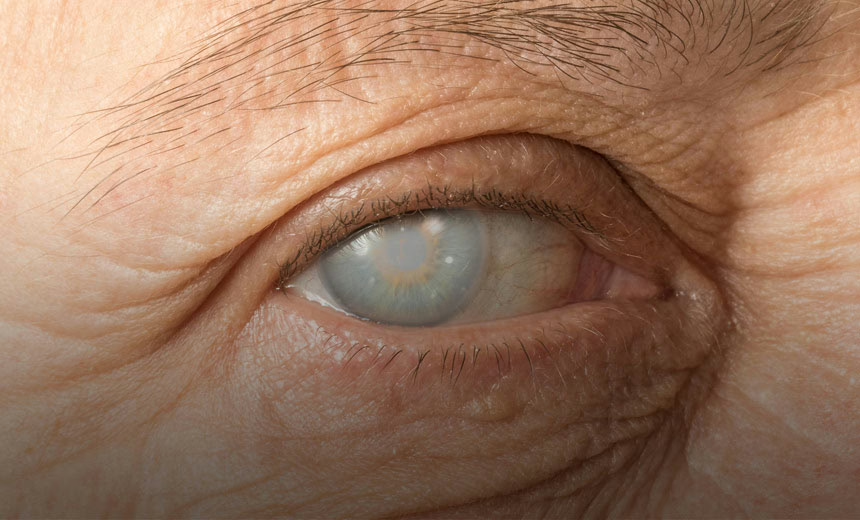Subscribe to eyeMatters periodic news
"*" indicates required fields
Cloudy … with a chance of cataracts

The eye’s lens is a normally transparent structure that sits behind the iris and works in a manner similar to the lens of a camera. Together with the cornea, it helps to refract (bend) and focus light rays onto the retina. Nerve cells in the retina then transform the light into electrical impulses, which travel to the brain via the optic nerve and produce an image. The lens can change shape to adjust the eye’s focus on near and far objects.
A cataract is a clouding of the lens, which affects a person’s ability to see, and is a leading cause of blindness around the world. Most cataracts develop in older people, but this is not always the case. Some people may also be born with a cataract (known as a congenital cataract).
Risk factors include family history, prolonged exposure to sunlight, diabetes, hypertension, obesity, smoking, alcohol consumption, prolonged use of corticosteroids, statin medications (for high cholesterol), previous eye injury or eye surgery, hormone replacement therapy and a high degree of myopia (short-sightedness).
Symptoms
Cataracts are not painful and vision may not be affected during the early stages. However, this changes as the cataract advances and signs may include:
- Blurred or dim vision
- Difficulty seeing at night or in low-light situations
- Light/glare sensitivity
- Seeing halos
- Colours appear faded or yellow
- Double vision in the affected eye
- Frequently changing glasses or contact lens prescription
Today’s treatment options
Early diagnosis and treatment of cataracts is the key to preventing vision loss. Advanced cataracts are usually obvious and easy to diagnose. However, early cataracts can be a bit harder. If your GP or optometrist diagnoses (or suspects) a cataract, he/she will refer you to an ophthalmologist for further investigation and management.
In the early stages, a stronger glasses or contact lens prescription may be adequate. When this is no longer the case and your ability to function on a daily basis is affected, then it could be time to consider surgery.
Cataract surgery involves removing the affected lens under local anaesthesia and replacing it with a clear artificial lens (known as an intraocular lens or IOL). The IOL cannot be felt once placed inside the eye. The operation itself takes less than thirty minutes and can be performed in a day surgery or in hospital.
Cataract surgery is the most frequently performed surgical procedure around the world. With laser cataract surgery, a femtosecond laser is used to complete several steps that the ophthalmic surgeon would normally perform manually. Using the laser may provide additional benefits in certain situations, but it is important to understand that both laser-assisted and conventional cataract surgery are highly successful and safe procedures.
The latest in lens technology
IOLs have evolved over time and there are now various options available to correct pre-existing refractive errors (e.g. short-sightedness, long-sightedness or astigmatism). Similar to the lenses in glasses, IOLs are manufactured to meet a certain prescription. Glasses may still be required for certain activities following surgery and this partly depends on the type of IOL chosen.
Monofocal lenses produce clear vision at a single distance (either near/reading or far), in contrast to bifocal IOLs which allow corrected vision at both near and far distances. However, trifocal lenses provide good vision at near, mid and far distances and give patients the best chance of getting out of glasses. Your ophthalmologist will discuss the advantages and disadvantages of each IOL and help you select the most appropriate one for your situation.
Once the affected lens is replaced, it is not possible to develop another cataract. However, a further procedure may sometimes be recommended to achieve even clearer vision.
Vision Eye Institute has a number of ophthalmologists who are highly experienced in the diagnosis and treatment of cataracts, including laser cataract surgery. Click here to find your nearest cataract clinic.
References
- The Royal Australian and New Zealand College of Ophthalmologists. Cataract Surgery Online Patient Advisory. Edition 2. Australia: Mi-tec Medical Publishing, 21 February 2019. Available at https://ranzco.edu/policies_and_guideli/cataract/ [Accessed 6 January 2021].
- American Academy of Ophthalmology. What Are Cataracts? USA, 11 December 2020. Available at https://www.aao.org/eye-health/diseases/what-are-cataracts [Accessed 6 January 2021].
- Davis G. The Evolution of Cataract Surgery. Mo Med 2016;113(1):58–62.
- American Academy of Ophthalmology. EyeWiki: Cataract. USA, 30 August 2020. Available at https://eyewiki.aao.org/Cataract [Accessed 6 Jan 2021].
The information on this page is general in nature. All medical and surgical procedures have potential benefits and risks. Consult your ophthalmologist for specific medical advice.
Date last reviewed: 2022-10-05 | Date for next review: 2024-10-05
